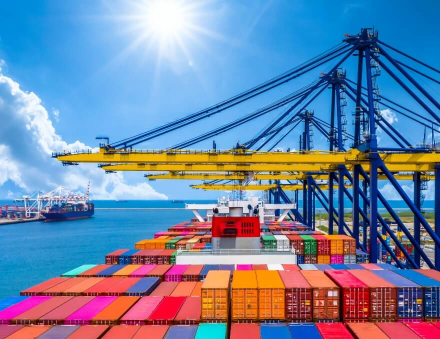

Optimizing Your Metals Supply Chain, Together
What our customers say about us
The challenge
We understand your challenges: demand volatility, persistent excess inventory, complex customer requirements, and ever-increasing sustainability requirements. Additionally, trade flow disruptions, a widening workforce skills gap, and declining access to quality resources, make planning your metals supply chain a unique puzzle.
What’s more, if you have legacy planning tools, you may be struggling to keep up with innovation in the industry. But you don’t have to do this alone. We can help you forge a supply chain that is resilient, agile, visible, and sustainable. That comes from identifying opportunities and delivering on them.
-
SituationLegacy systems force you to rework plans at every level.
-
ComplicationUsing spreadsheets, ERPs, or isolated planning tools prevents collaboration across stakeholders.
-
QuestionHow do you standardize planning and reporting standards?
-
AnswerCreate company-wide plans that align different entities within the supply chain with an integrated planning solution.

-
SituationYour supply chain is divided into localized sub-plans.
-
ComplicationThere is limited visibility over your whole operation – Materials Allocation, Distribution Requirements, and Master Production Schedules.
-
QuestionHow do you improve inventory control?
-
AnswerDigitalize your operations to reduce excess inventory and material wastage.

-
SituationPlans are often complex, involving global distribution centers, stocking points.
-
ComplicationPlanners are not supported with the correct tools to resolve process bottlenecks, high work-in-progress orders, and order lead time, to name a few.
-
QuestionHow do you support your planners in making better decisions?
-
AnswerImplement a solution that calculates several outcomes at the same time to reduce errors and save time.

-
SituationThere is an increased focus on sustainability regulations and the need to be green.
-
ComplicationSustainability and ESG targets increase your production, material, and energy costs, reducing revenues and profits.
-
QuestionHow do you balance sustainability with meeting customer SLAs whilst still being profitable?
-
AnswerA solution offering S&OP, MPS, and detailed scheduling can help you reduce wastage and cost as well as improve operational agility.

-
SituationDecisions involving replenishing and reserving materials are often made based on heuristics.
-
Complication
While rule-of-thumb decisions may be practical, they are not optimal, leading to inefficiency and shorter planning horizons. -
QuestionHow can you make better reservation decisions and improve my operational KPIs?
-
AnswerMake better decisions with longer planning horizons that align with your operational goals and KPIs.

-
SituationAs planning is a time-boxed exercise, it is easier to make decisions in the short term.
-
ComplicationBut the long-term impact is difficult to verify and confirm.
-
QuestionHow can your planners make better and longer-term plans?
-
AnswerAdvanced planning tools enable planners to do more in the time available whilst improving overall plan quality and deliverability.

-
SituationLegacy systems force you to rework plans at every level.
-
ComplicationUsing spreadsheets, ERPs, or isolated planning tools prevents collaboration across stakeholders.
-
QuestionHow do you standardize planning and reporting standards?
-
AnswerCreate company-wide plans that align different entities within the supply chain with an integrated planning solution.

-
SituationYour supply chain is divided into localized sub-plans.
-
ComplicationThere is limited visibility over your whole operation – Materials Allocation, Distribution Requirements, and Master Production Schedules.
-
QuestionHow do you improve inventory control?
-
AnswerDigitalize your operations to reduce excess inventory and material wastage.

-
SituationPlans are often complex, involving global distribution centers, stocking points.
-
ComplicationPlanners are not supported with the correct tools to resolve process bottlenecks, high work-in-progress orders, and order lead time, to name a few.
-
QuestionHow do you support your planners in making better decisions?
-
AnswerImplement a solution that calculates several outcomes at the same time to reduce errors and save time.

-
SituationThere is an increased focus on sustainability regulations and the need to be green.
-
ComplicationSustainability and ESG targets increase your production, material, and energy costs, reducing revenues and profits.
-
QuestionHow do you balance sustainability with meeting customer SLAs whilst still being profitable?
-
AnswerA solution offering S&OP, MPS, and detailed scheduling can help you reduce wastage and cost as well as improve operational agility.

-
SituationDecisions involving replenishing and reserving materials are often made based on heuristics.
-
Complication
While rule-of-thumb decisions may be practical, they are not optimal, leading to inefficiency and shorter planning horizons. -
QuestionHow can you make better reservation decisions and improve my operational KPIs?
-
AnswerMake better decisions with longer planning horizons that align with your operational goals and KPIs.

-
SituationAs planning is a time-boxed exercise, it is easier to make decisions in the short term.
-
ComplicationBut the long-term impact is difficult to verify and confirm.
-
QuestionHow can your planners make better and longer-term plans?
-
AnswerAdvanced planning tools enable planners to do more in the time available whilst improving overall plan quality and deliverability.

Drive long-term manufacturing improvements with The Logic Factory
Creating a single source of truth
By centralizing data management and removing data silos, improve the visibility of your global supply chain.
Improving forecast accuracy and operational agility
Develop optimal statistical forecasts with attribute-based demand forecasting. Create supply plans that maximize resource usage, increase turnover, and reduce working capital.
Improving decision-making, productivity, and delivery performance
Real-time insights and KPI-driven optimization can help you build a plan that increases on-time delivery and improves throughput.
Mastering complex scheduling
Streamline production planning, leverage smart capacity planning, and gain end-to-end supply chain visibility. Optimize complex scheduling, including casting, hot rolling, cold rolling, and finishing operations.
Simulating what-if scenarios
Be responsive in a rapidly changing world. Simulate what-if scenarios to help your operations become more agile, resilient, and sustainable.
Enhancing production planning
Achieve complete visibility of upstream and downstream work orders and material flow synchronization. Boost production and reduce wastage of raw materials.



